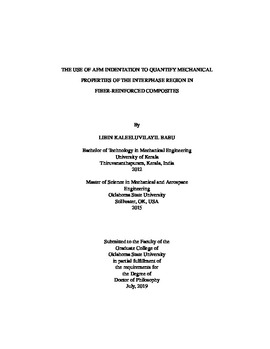| dc.contributor.advisor | Singh, Raman P. | |
| dc.contributor.author | Babu, Libin Kaleeluvilayil | |
| dc.date.accessioned | 2020-01-30T15:03:13Z | |
| dc.date.available | 2020-01-30T15:03:13Z | |
| dc.date.issued | 2019-07 | |
| dc.identifier.uri | https://hdl.handle.net/11244/323368 | |
| dc.description.abstract | Interphase is the region in the vicinity of the reinforcing fiber in the polymer composites with properties distinct from the bulk matrix. Investigation of these nano- and micro interphase regions have been done using conventional indentation techniques, followed by closed-form solutions applicable to the indentation in a semi-infinite space. However, due to the presence of the fiber the interphase region can be considered only as a semi-infinite space with rigid constraint. An integrated approach using AFM (Atomic Force Microscopy) based indentation and FEA (Finite Element Analysis) is used to investigate the effect of the fiber constraint on the mechanical properties of the interphase region. Obtained results indicate that the thickness of the interphase region is approximately 250 nm, based on the gradient in the elastic modulus as a function of radial distance from the fiber. 3D FEA using an elasto-plastic material model indicates that the fiber constraint effect is considerable in the region less than 40 nm away from the fiber. The time-dependent behavior of the interphase region is studied using a constant displacement approach, and the distinct viscoelastic response of the interphase region is observed as a function of the radial distance to the fiber. FEA using a linear viscoelastic material model shows that the influence of fiber constraint on the evaluation of the viscoelastic properties is distinguishable only within 20 nm away from the fiber. Due to the limited extent of influence of fiber constraint effect, the distinct behavior of the interphase region in terms of elastic and viscoelastic properties is confirmed. Additionally, it is shown that consideration of an axisymmetry assumption for modeling the interphase region leads to an overestimation of the properties of the region. This technique is further implemented to demonstrate the effect of UV irradiation on the interphase region. Methodical analysis of the data indicates that the response of epoxy to UV irradiation is influenced by the proximity to the reinforcement and carbon fiber reinforcement hinders the photo-degradation of epoxy. Furthermore, the influence of the thermal mismatch between the fiber and the matrix on the formation of the interphase and the effect of post-curing are examined using the approach considered in this study. Results indicate that the presence of thermal stresses greatly impact the width of the interphase region and its behavior. | |
| dc.format | application/pdf | |
| dc.language | en_US | |
| dc.rights | Copyright is held by the author who has granted the Oklahoma State University Library the non-exclusive right to share this material in its institutional repository. Contact Digital Library Services at lib-dls@okstate.edu or 405-744-9161 for the permission policy on the use, reproduction or distribution of this material. | |
| dc.title | Use of AFM Indentation to Quantify Mechanical Properties of the Interphase Region in Fiber-Reinforced Composites | |
| dc.contributor.committeeMember | Sallam, Khaled A. | |
| dc.contributor.committeeMember | Wang, Shuodao | |
| dc.contributor.committeeMember | Kim, DoYoung | |
| osu.filename | Babu_okstate_0664D_16359.pdf | |
| osu.accesstype | Open Access | |
| dc.type.genre | Dissertation | |
| dc.type.material | Text | |
| dc.subject.keywords | atomic force microscopy | |
| dc.subject.keywords | carbon fiber | |
| dc.subject.keywords | composites | |
| dc.subject.keywords | interphase | |
| thesis.degree.discipline | Mechanical and Aerospace Engineering | |
| thesis.degree.grantor | Oklahoma State University | |
